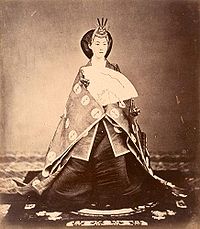
Uchida Kuichi
Encyclopedia


was a pioneering Japanese
Japanese people
The are an ethnic group originating in the Japanese archipelago and are the predominant ethnic group of Japan. Worldwide, approximately 130 million people are of Japanese descent; of these, approximately 127 million are residents of Japan. People of Japanese ancestry who live in other countries...
photographer from Nagasaki. He was greatly respected as a portrait photographer and was the only photographer granted a sitting to photograph the Emperor Meiji
Emperor Meiji
The or was the 122nd emperor of Japan according to the traditional order of succession, reigning from 3 February 1867 until his death...
.
Uchida was adopted at the age of 13, following his father's death, by the physician Matsumoto Jun
Matsumoto Jun (physician)
' was a Japanese physician who served as the personal physician to the last Shogun, Tokugawa Yoshinobu. He also studied photography with J. L. C...
(formerly Matsumoto Ryōjun) (1832 - 1907), who was at that time studying photography with J. L. C. Pompe van Meerdervoort
J. L. C. Pompe van Meerdervoort
Johannes Lijdius Catharinus Pompe van Meerdervoort was a Dutch physician based in Nagasaki, Japan...
(1829 - 1908).

Ueno Hikoma
was a pioneer Japanese photographer, born in Nagasaki. He is noted for his fine portraits, often of important Japanese and foreign figures, and for his excellent landscapes, particularly of Nagasaki and its surroundings...
in their native city of Nagasaki. When he was 16 years old, he purchased his first photographic equipment and by 1863, when he was 19, he was importing and selling photographic equipment. He opened his first photographic studio
Photographic studio
A photographic studio is both a workspace and a corporate body. As a workspace it is much like an artist’s studio, but providing space to take, develop, print and duplicate photographs. Photographic training and the display of finished photographs may also be accommodated in a photographic studio...
in 1865 with Morita Raizō
Morita Raizo
was a renowned Japanese photographer.-References:...
in Osaka
Osaka
is a city in the Kansai region of Japan's main island of Honshu, a designated city under the Local Autonomy Law, the capital city of Osaka Prefecture and also the biggest part of Keihanshin area, which is represented by three major cities of Japan, Kyoto, Osaka and Kobe...
, the first studio in that city.
In 1866 Uchida moved his studio to Bashamichi in Yokohama
Yokohama
is the capital city of Kanagawa Prefecture and the second largest city in Japan by population after Tokyo and most populous municipality of Japan. It lies on Tokyo Bay, south of Tokyo, in the Kantō region of the main island of Honshu...
, then in 1869 moved the studio again, this time to the district of Asakusa
Asakusa
is a district in Taitō, Tokyo, Japan, most famous for the Sensō-ji, a Buddhist temple dedicated to the bodhisattva Kannon. There are several other temples in Asakusa, as well as various festivals.- History :...
in Tokyo
Tokyo
, ; officially , is one of the 47 prefectures of Japan. Tokyo is the capital of Japan, the center of the Greater Tokyo Area, and the largest metropolitan area of Japan. It is the seat of the Japanese government and the Imperial Palace, and the home of the Japanese Imperial Family...
. He soon became known as the best portrait photographer in Tokyo.
Having achieved this reputation for excellence, Uchida Kuichi was the only photographer granted a sitting by the Emperor Meiji, who was considered a living deity and rarely seen in public. The portrait session took place in 1872 on a commission by the Imperial Household Ministry
Imperial Household Agency
The is a government agency of Japan in charge of the state matters concerning Japan's imperial family and also keeping the Privy Seal and the State Seal...
to photograph the Emperor and Empress Haruko in full court dress and everyday robes. In 1873, Uchida again photographed the Emperor, who this time wore military dress, and a photograph from this sitting became the official imperial portrait. Copies of the official portrait were distributed among foreign heads of state and Japanese regional governmental offices and schools, but their private sale was prohibited. Nevertheless, many copies of the photograph were made and circulated on the market. The emperor was not photographed again until 1888 or 1889.
In 1872 Uchida was commissioned to accompany the emperor on a tour through central Japan and Kyūshū
Kyushu
is the third largest island of Japan and most southwesterly of its four main islands. Its alternate ancient names include , , and . The historical regional name is referred to Kyushu and its surrounding islands....
, and to take photographs of the people and places during the journey. He was not permitted to photograph the emperor, however.
Uchida was very successful commercially and his life was even the subject of a kabuki
Kabuki
is classical Japanese dance-drama. Kabuki theatre is known for the stylization of its drama and for the elaborate make-up worn by some of its performers.The individual kanji characters, from left to right, mean sing , dance , and skill...
play written and performed in 1870.
He died in 1875 of tuberculosis
Tuberculosis
Tuberculosis, MTB, or TB is a common, and in many cases lethal, infectious disease caused by various strains of mycobacteria, usually Mycobacterium tuberculosis. Tuberculosis usually attacks the lungs but can also affect other parts of the body...
.

